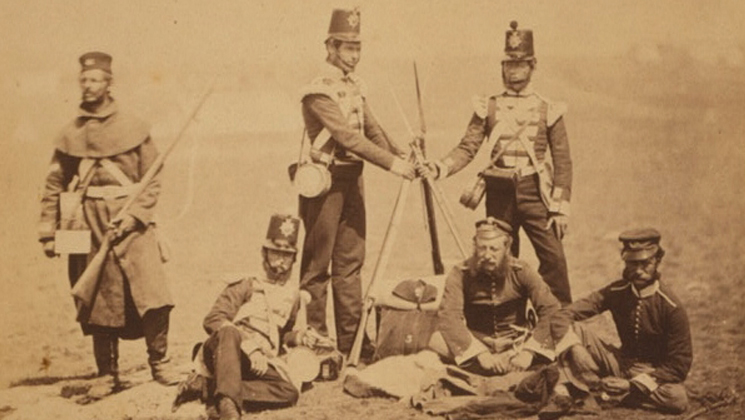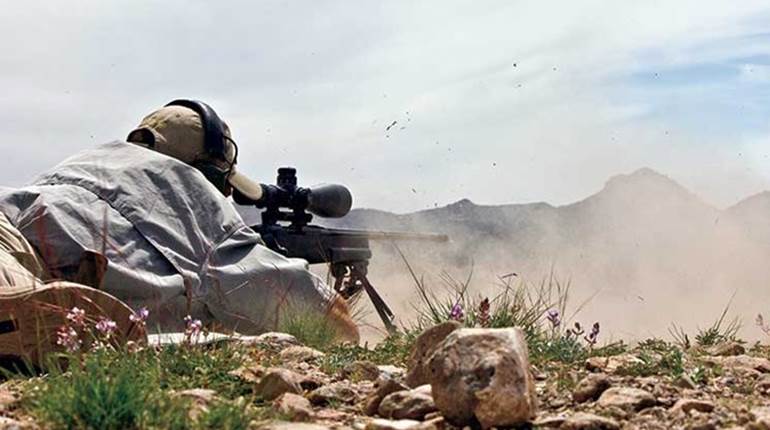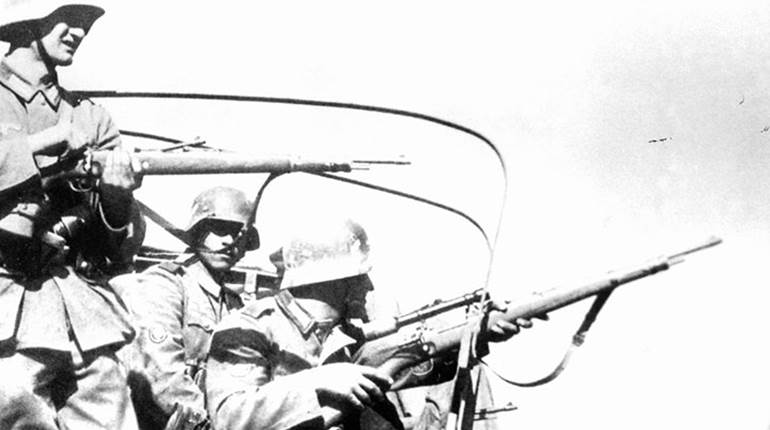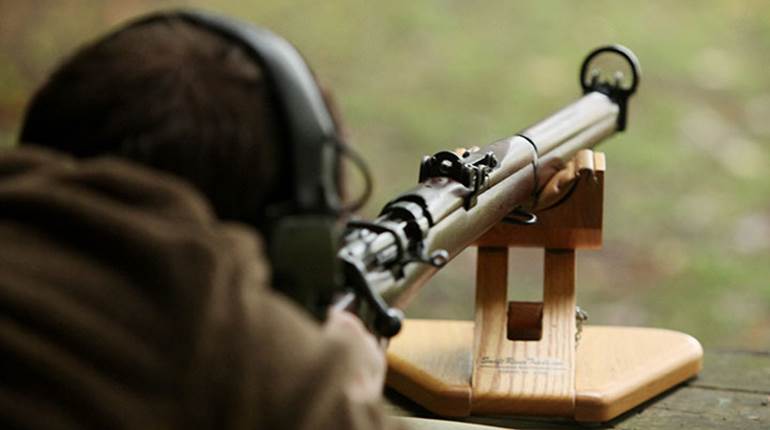
In the Crimea, 1853, British soldiers of the 48th Regiment of Foot pose in their splendid and highly impractical red jackets (above). They have Pattern 1851 “Minnie” rifles.
By the early 19th century, the longarms being offered to the discerning civilian shooter had improved beyond all recognition compared to those then in military service. In Europe and America, the smoothbore flintlock musket had remained the preeminent longarm for several reasons. Firstly, and most obviously, was that of cost. Over many decades they had been issued in colossal numbers, and to replace them with more modern types was financially prohibitive for most governments. Secondly, while the rifled barrel was becoming far more affordable, it was still primarily the preserve of the sporting shooter, with little interest being shown by the military. After all, linear warfare was still the preferred method of fighting, and of what use was an expensive-to-produce rifled arm when speed of loading was still of greater importance than accuracy? Besides, actually teaching the common soldier to shoot properly would imply that he possessed a level of intelligence that was clearly unlikely. The regular soldier existed to carry loads, obey orders and, above all, not think for himself.

Nevertheless, despite the military’s requirements, technology marched inexorably forward, and within the commercial gun trade, firearm design and function continued to improve. By the late 1820s, percussion, or caplock, ignition was being widely adopted. Not only did it markedly improve the speed of loading, it no longer created a blinding, flinch-inducing flash just in front of the shooter’s face. Of greater significance was that, for the first time, a caplock longarm could be carried loaded and primed almost indefinitely without moisture entering the priming pan, which could, and often did, render the main charge useless when it was most needed.
Eventually, these advances could no longer be ignored by even the most obdurate ordnance boards, and percussion rifles began to gradually appear in arsenals across Europe. However, what was to eventually revolutionize warfare was not so much the method of igniting a musket, but the bullet that it fired.

As so often happens, two near-parallel inventions by different men, expatriate German Henri-Gustave Delvigne (1799-1876) and Frenchman Louis-Etienné de Thouvenin (1789-1882), paved the way for the perfection of a new form of projectile that was to revolutionize the art of accurate shooting. Delvigne invented a system whereby the breech plug of the firearm was slightly smaller than the internal diameter of the bore, creating a narrow lip. When seated (with two or three hard blows), the bullet skirt deformed on the lip, causing it to grip the bore of the musket. He later improved the process by introducing a hollow-based conical bullet (a type already in production in England as a result of experimental work by Capt. John Norton and gunmaker William Greener) and, in an attempt to prevent undue deformation, Delvigne placed a wooden sabot in its base.
Thouvenin improved upon this by producing a carabine a tige, which had a steel spigot in the base of the breech that expanded the skirt of the bullet when it was rammed onto it, pushing it against the bore of the musket. Both methods worked tolerably well but had shortcomings, noticeably with regard to fouling and accuracy, as the bullets were invariably damaged during loading. It was left to a French army officer named Claude Etienne Minié to eventually perfect the expanding bullet in 1850 by making its body smaller and slimmer and inserting a steel cup into its hollow base. When fired from a rifled-musket, the propellant gas forced the cup up into the skirt of the bullet, expanding it so it gripped the rifling. It worked very well for the most part, but Miniés were prone to blowing the cup through the bullet, leaving a ring of lead embedded in the bore of the rifle.
The United States Army had been intrigued by the Minié system, but seemed incapable of making any commitment with regard to its adoption. It had initially adopted the tige system, inheriting all of its shortcomings, but it had also produced thousands of percussion, .54-cal. U.S. Model 1841 “Mississippi” rifles that could, if a decision was made, be used with the new bullet. It was left to James H. Burton of Harper’s Ferry Arsenal to solve the problem by strengthening the base of the bullet and doing away completely with the cup. The result was a .58-cal. projectile that was prelubricated and slightly undersized to aid loading—and it was very accurate. It became the U.S. Army’s standard, being used in the new Model 1855 Percussion Rifle-Musket. As Col. Craig prophetically stated in his “1854 Report of the Chief of Ordnance,” the new bullet “ … indicated so great a superiority of the rifled bore with the elongated expanding ball, that it seems not improbable that the use of smooth-bored arms and spherical balls may be entirely superseded.” How right he was.
Britain, always keen to minimize spending on its army, at first converted surplus flintlock smoothbores to percussion, introduced as the Pattern 1839 musket, but made no attempt to introduce rifling. The Pattern 1839s performed so poorly that the Pattern 1842 percussion musket was produced not long thereafter. It fired a large 0.75" conical bullet but, still unrifled, proved to be a disastrous half-measure. In 1846, tests were undertaken by the Royal Engineers at Chatham, in England, to determine just how effective these muskets were, and the results made for depressing reading.

“It appears by these experiments that as a general rule musketry fire should never be opened beyond 150 yards and certainly not exceeding 200 yards. At this distance half the number of shots missed a target 11 feet 6 in and at 150 yards a very large proportion also missed. At 75 and 100 yards every shot struck the target only 2 feet wide and had the deviation increased simply as the distance every shot ought to have struck the target 6 feet wide at 200 yards. Instead of this however some were observed to pass several yards to the right and left some to fall 30 yards short and others to pass as much beyond and this deviation augmented in a still greater degree as the range was increased. It is only then under peculiar circumstances such as when it may be desirable to bring a fire on field artillery when there are no other means of replying to it that it ought ever to be thought of using the musket at such distances as 400 yards.”
So dismal was the performance that they were deemed the worst muskets in European service. To rectify this, a rifled Pattern 1842 version was manufactured, but was soon replaced by the first Minié rifle, the Pattern 1851, which confusingly was identical externally to the previous models. It did, however, have a slightly reduced bore size of 0.70" and used a hollow-based conical bullet that owed much of its development to Norton and Greener. The “Minnie rifle” proved a landmark in British military longarms, but was never actually a general-issue arm. However, it did get into the hands of fighting troops, with some interesting results.
First Blood
There had been colonial wars fought around the world for decades, involving many of the world’s most powerful armed forces, but most were unequal struggles between native tribes and well-armed European or American soldiers, with predictably bloody outcomes. Nonetheless, a small number of such wars were to prove a testing ground for the new rifle technology. This was to pose something of a problem for armies who were equipping themselves with these guns, for soldiers had been traditionally taught to estimate distances using a simple visual system.
“At fifty yards, buttons and facial features can be seen clearly. At one hundred yards, the facial features are blurred and buttons seem to form a continuous line. At one hundred and fifty yards, the face is a white disc and no uniform detail is visible. At 200 yards, arms, body and legs are visible, and the head is a dark blob.”

There was little point in proceeding beyond 200 yds., as it was generally accepted as the maximum effective killing range for the common musket. The problem was that the rifles now available could shoot with precision out to distances considerably in excess of that. Rather than teach range estimation, the British solution was to rely on an experienced NCO to estimate the range and pass the information on to the soldiers, a decision that was to have unfortunate consequences in later wars. When the first P’51 rifles were issued to British troops during the Cape Border Wars (1846-1852), the men delighted in the unaccustomed range and accuracy of their new arms. Private G. Wickens, later writing home, said, “When the enemy began to show themselves … we opened fire on them. We made them move (off) at 1,200 yards.” While it is telling that he did not actually state that any enemy were hit at such a range, in a small way this action heralded a new era of military marksmanship. This was to expand greatly with the later issue of some 17,000 P’51 Minié rifles to British soldiers fighting against Russia in the far-flung Crimean Peninsula (1854-1856).
The war had all the overtones of later, greater conflicts: trenches, tunnels and mining and artillery barrages became commonplace, but it was the close proximity of the Russian soldiers that began to attract the attention of the more experienced shots in the British army. The P’51-armed British soldiers had a huge advantage over the Russians, who were, for the most part, armed with smoothbore percussion muskets. Nevertheless, lack of training meant that the British soldiers were unused to adjusting their sights for longer ranges, as the reporter W.H. Russel of The London Times noted. “As the Russians came within six hundred yards … out rings a volley of Mini (sic) musketry. The distance is too great; the Russians are not checked. But ’ere they come within one hundred and fifty yards, another deadly volley flashes from the levelled rifles, and carried death and terror into the Russians. They wheel about … .”

At first reading, this may appear to be an unimpressive performance, but bear in mind the results of the tests only a decade earlier with the P’1842 musket. Long hours spent in trenches observing the Russians resulted in British soldiers pairing off and setting themselves up in advantageous positions, from where they could sharpshoot into the Russian artillery lines. As an observer, Lt.-Col. D. Davidson commented: “We have a striking example of an incident which occurred in the rifle pits before Sebastopol. One soldier was observed with his rifle carefully pointed at a distant (Russian) embrasure, and with his finger on the trigger ready to pull, while by his side lay another with a telescope directed at the same object. He was anxiously watching the moment when the (Russian) gunner should show himself, in order that he may give the signal to the other to fire.” This is possibly the first recorded instance of a sharpshooter and observer working together, and the work they did was certainly not wasted. At first the Russians were more curious than afraid, as one officer, Naum Gorbunov, wrote: “We dismounted from our horses and watched with curiosity these strange things … [they] were in no way meant for us. But after a few seconds we learned from experience the significance of these ‘thimbles’.”
It was not long before the Russian gunners began to close their embrasures as protection against the bullets of the riflemen, and even their infantrymen became very wary of showing themselves above the parapets. For the first time in warfare, the artillery, normally beyond range for infantry retaliation, were an attainable target. Sir Henry Bartle Frere (1815-1884), a British colonial administrator much experienced in warfare, saw at once what the implications of the introduction of this new technology, and in 1855 he wrote:
“[The rifle’s] use implies skilful workmen in our ranks, instead of pipe-clayed automatons. It also implies a further change in our tactics … with open files and ranks, each man a skilful combatant. They would sweep their enemies from the earth, themselves almost unseen while a single discharge from a company 1000 yards distance would annihilate the best field battery … and cavalry would be of little value against them.”
Sadly, his understanding was lost on almost every other army commander in Britain and the United States. If more proof were required, then the cannon fired at Fort Sumter on April 12, 1861, were to reinforce the fact with devastating consequences. Ones we shall examine in our next installment.






































